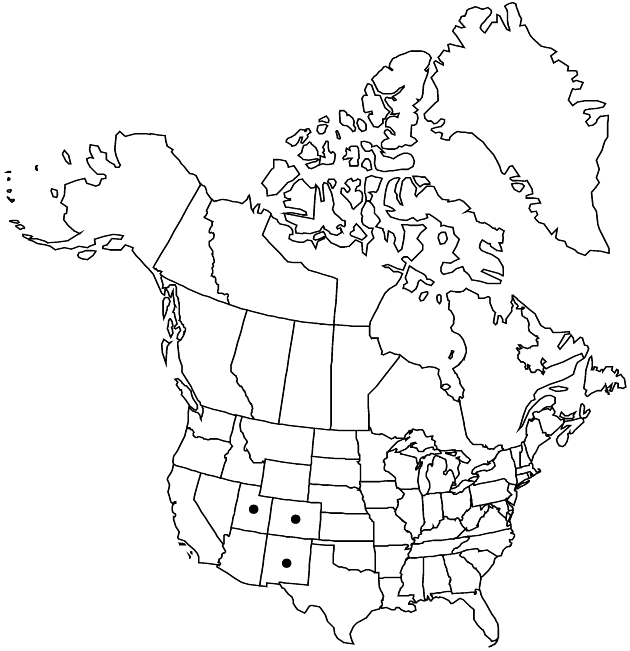Difference between revisions of "Ericameria parryi var. attenuata"
Phytologia 75: 88. 1993.
Common names: Narrow-bract rabbitbrush
Basionym: Bigelowia howardii var. attenuata M. E. Jones Proc. Calif. Acad. Sci., ser. 2, 5: 691. 1895
Synonyms: Chrysothamnus parryi subsp. attenuatus (M. E. Jones) H. M. Hall & Clements
FNA>Volume Importer |
FNA>Volume Importer |
||
| Line 11: | Line 11: | ||
|name=Bigelowia howardii var. attenuata | |name=Bigelowia howardii var. attenuata | ||
|authority=M. E. Jones | |authority=M. E. Jones | ||
| + | |rank=variety | ||
|publication_title=Proc. Calif. Acad. Sci., ser. | |publication_title=Proc. Calif. Acad. Sci., ser. | ||
|publication_place=2, 5: 691. 1895 | |publication_place=2, 5: 691. 1895 | ||
| Line 17: | Line 18: | ||
|name=Chrysothamnus parryi subsp. attenuatus | |name=Chrysothamnus parryi subsp. attenuatus | ||
|authority=(M. E. Jones) H. M. Hall & Clements | |authority=(M. E. Jones) H. M. Hall & Clements | ||
| + | |rank=subspecies | ||
}} | }} | ||
|hierarchy=Asteraceae;Asteraceae tribe Astereae;Ericameria;Ericameria parryi;Ericameria parryi var. attenuata | |hierarchy=Asteraceae;Asteraceae tribe Astereae;Ericameria;Ericameria parryi;Ericameria parryi var. attenuata | ||
| Line 32: | Line 34: | ||
|elevation=1700–3000 m | |elevation=1700–3000 m | ||
|distribution=Colo.;N.Mex.;Utah. | |distribution=Colo.;N.Mex.;Utah. | ||
| − | |discussion=<p>S. L. Welsh et al. (1987) noted that characteristics used to distinguish < | + | |discussion=<p>S. L. Welsh et al. (1987) noted that characteristics used to distinguish <i></i>var.<i> howardii</i> from <i></i>var.<i> attenuata</i> (distalmost leaves overtopping arrays and pale-colored florets) fail as diagnostic features for plants from Utah.</p> |
|tables= | |tables= | ||
|references= | |references= | ||
| Line 41: | Line 43: | ||
-->{{#Taxon: | -->{{#Taxon: | ||
name=Ericameria parryi var. attenuata | name=Ericameria parryi var. attenuata | ||
| − | |||
|authority=(M. E. Jones) G. L. Nesom & G. I. Baird | |authority=(M. E. Jones) G. L. Nesom & G. I. Baird | ||
|rank=variety | |rank=variety | ||
| Line 56: | Line 57: | ||
|publication year=1993 | |publication year=1993 | ||
|special status= | |special status= | ||
| − | |source xml=https://jpend@bitbucket.org/aafc-mbb/fna-data-curation.git/src/ | + | |source xml=https://jpend@bitbucket.org/aafc-mbb/fna-data-curation.git/src/eaa6e58056e40c9ef614d8f47aea294977a1a5e9/coarse_grained_fna_xml/V19-20-21/V20_133.xml |
|tribe=Asteraceae tribe Astereae | |tribe=Asteraceae tribe Astereae | ||
|genus=Ericameria | |genus=Ericameria | ||
Revision as of 19:25, 16 December 2019
Plants 20–60 cm. Leaves moderately crowded, green; blades 1-nerved, linear, 20–40 × ca. 1 mm, faces glabrous or sparsely hairy, eglandular, somewhat viscid; distalmost shorter than arrays. Heads 5–10 in compact, racemiform arrays. Involucres 11–12.5 mm. Phyllaries 13–22, apices erect, attenuate. Florets 5–7; corollas clear yellow, 10–11 mm, tubes glabrous, throats gradually dilated, lobes 1.5–2 mm. 2n = 18.
Phenology: Flowering late summer–fall.
Habitat: Mountain slopes, dry, stony soils, sagebrush, pinyon-juniper, ponderosa pine, and aspen communities
Elevation: 1700–3000 m
Distribution

Colo., N.Mex., Utah.
Discussion
S. L. Welsh et al. (1987) noted that characteristics used to distinguish var. howardii from var. attenuata (distalmost leaves overtopping arrays and pale-colored florets) fail as diagnostic features for plants from Utah.
Selected References
None.
Lower Taxa
None.